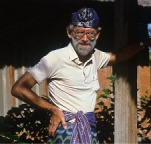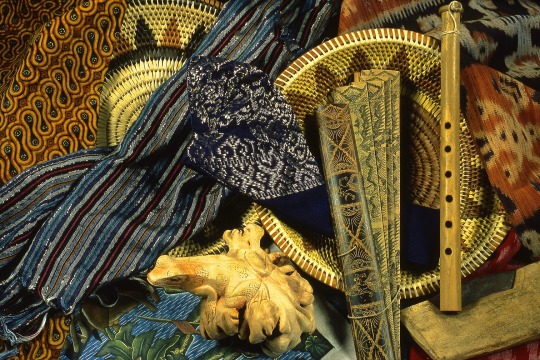 |
CULTURES IN CONTEXT Bali: Ancient and Modern 6. Village Crafts : 056-074 |

056. Though growing rice in flooded fields is hard work, a rich soil and favorable climate guarantee high yields … and people, therefore, have time to be creative in all sorts of ways. Seemingly, almost everyone in Bali is an artist of some sort. |
057. Some crafts are found in a few villages; others everywhere. For example, before paper and printing presses were invented scholars wrote on strips of palm leaf, and there are still a few men making books in the old way. These books are known as "lontars", after the palm from which they were made. In keeping with puppet shows, such books commonly illustrate stories from the ancient Indian epic poem Ramayana. |
058. Both words and pictures are etched into the leaf using a sharp knife, and a black stain is used to highlight the cuts. The long fingernails indicate that their owner does not do manual work! |
059. Later the book will be bound between wooden covers, by threading a string through holes in each page. This composite photo shows both sides of the pages … each of which will typically be about 30cm long and 4cm wide. |
060. While book production was never widespread, every woman once had a loom on which to weave cloth for her own family. |
061. Now, in some villages, woven textiles are produced in quantity for sale to tourists. Both shops and market stalls offer a range of fabrics for sale. |
062. Some of these may then be made into garments in small workshops using treadle sewing machines. |
063. Batik is produced here too. The pattern is first drawn on white (or near white) cotton cloth, and the areas they want to remain white are covered with hot waterproof wax. |
064. The cloth is then dipped in a dye bath of the lightest colour to be used. When it is dry the wax will be removed with boiling water, the next set of designs will be outlined with the wax and it is dyed again … as many times as there are colours to be used. |
065. The wax cracks and lets through some of the dye but it makes a nice pattern, and offers another source of income today. |
066. The other textile for which Bali is famous is ikat, in which warp or weft threads, or both, are subject to a process of “resist dying “ (tie-dying) before weaving. Individual yarns or bundles of yarns are bound with a tight wrapping applied in the desired pattern, and the yarns are then dyed. |
067. Because of way it is woven the patterns produced on the finished cloth are inevitably ragged. |
068. Painting is another old craft influenced by tourism. Once men ... and it is only men who paint in Bali ... once men decorated temples and palaces like this. |
069. Today they paint pictures of everyday life, which they sell to tourists. |
070. In the same way men once carved stone statues used outside temples to scare away evil spirits. Some still do work in stone … |
071. But many have switched to carving wood instead, which is lighter and easier for visitors to carry home. These are garudas (a mythical bird), carvings of which were once found only in temples. |
072. Masks are also popular with tourists. These are patterned on those used in dances to represent witches and evil spirits |
073. They also weave baskets in Bali. Many are sold to tourists, but some are for domestic use. |
074. These are for the roosters used in cock fighting. Since they are trained to kill one another, each bird must have its own basket. There's no bottom to it, so they can feed easily, and their owner can get them out quickly when required. |
![]()
Text, photos and recordings
by John Tyman
Intended for Educational Use
Only.
Contact Dr. John Tyman at johntyman2@gmail.com
for information regarding public
or commercial use.
![]()
www.hillmanweb.com
Photo processing, Web page layout,
formatting and hosting by
William
Hillman ~ Brandon, Manitoba ~ Canada